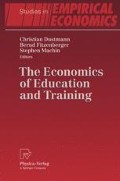Abstract
Utilizing parametric and nonparametric techniques, we asses the impact of a heretofore relatively unexplored ‘input’ in the educational process, time allocation, on the distribution of academic achievement. Our results indicate that school year length and the number and average duration of classes affect student achievement. However, the effects are not homogeneous — in terms of both direction and magnitude — across the distribution. We find that test scores in the upper tail of the distribution benefit from a shorter school year, while a longer school year increases test scores in the lower tail. Furthermore, test scores in the lower quantiles increase when students have at least eight classes lasting 46–50 min on average, while test scores in the upper quantiles increase when students have seven classes lasting 45 min or less or 51 min or more.
Access this chapter
Tax calculation will be finalised at checkout
Purchases are for personal use only
Preview
Unable to display preview. Download preview PDF.
References
Abadie A (2002) Bootstrap tests for distributional treatment effects in instrumental variable mod- els. J Am Stat Assoc 97:284-292
Abrevaya J (2001) The effects of demographics and maternal behavior on the distribution of birth outcomes. Empir Econ 26:247-257
Altonji JG, Elder TE, Taber CR (2005) Selection on observed and unobserved variables: assessing the effectiveness of catholic schools. J Political Econ 113:151-184
Amin S, Rai AS, Topa G (2003) Does microcredit reach the poor and vulnerable? Evidence from Northern Bangladesh. J Develop Econ 70:59-82
Arias O, Hallock KF, Sosa-Escudero W (2001) Individual Heterogeneity in the returns to schooling: instrumental variables quantile regression using twins data. Empir Econ 26:7-40
Betts JR (2001) The impact of school resources on women’s earnings and educational attainment: findings from the national longitudinal survey of young women. J Labor Econ 19:635-657
Bishop JA, Formby JP, Zeager LA (2000) The effect of food stamp cashout on undernutrition. Econ Lett 67:75-85
Bitler MP, Gelbach JB, Hoynes HW (2005) What mean impacts miss: distributional effects of welfare reform experiments. Am Econ Rev (in press)
Boozer MA, Rouse CC (2001) Intraschool variation in class size: patterns and implications. J Urban Econ 50:163-189
Buchinsky M (2001) Quantile regression with sample selection: estimating women’s return to education in the U.S. Empir Econ 26:87-113
Dearden L, Ferri J, Meghir C (2002) The effect of school quality on educational attainment and wages. Rev Econ Stat 84:1-20
Epple D, Romano RE (1998) Competition between private and public schools, vouchers, and peer group effects. Am Econ Rev 88:33-62
Eren O, Millimet DL (2005) Time to misbehave? Unpublished manuscript, Department of Eco- nomics, Southern Methodist University
Figlio DN (2003) Boys named sue: disruptive children and their peers. Unpublished manuscript, Department of Economics, University of Florida
Firpo SP (2005) Efficient semiparametric estimation of quantile treatment effects. Econometrica (in press)
Goldhaber DD, Brewer DJ (1997) Why don’t schools and teachers seem to matter? assessing the impact of unobservables on educational productivity. J Hum Resour 32:505-523
Hanushek EA (1979) Conceptual and empirical issues in the estimation of educational production functions. J Hum Resour 14:351-388
Hanushek EA (1999) The evidence on class size. In: Mayer SE, Peterson P (eds) Earning and learning: how schools matter. Brookings Institute, Washington, DC, pp 130-168
Hoxby CM (1999) The productivity of schools and other local public goods producers. J Public Econ 74:1-30
Levin J (2001) For whom the reductions count: a quantile regression analysis of class size and peer effects on scholastic achievement. Empir Econ 26:221-246
Linton O, Maasoumi E, Whang YJ (2005) Consistent testing for stochastic dominance: a subsam- pling approach. Rev Econ Stud 72:735-765
Maasoumi E, Heshmati A (2000) Stochastic dominance amongst swedish income distributions. Econ Rev 19:287-320
Maasoumi E, Heshmati A (2005) Evaluating dominance ranking of PSID incomes by various household attributes. IZA Discussion paper no. 1727
Maasoumi E, Millimet DL (2005) Robust inference concerning recent trends in U.S. environmental quality. J Appl Econ 20:55-77
Maasoumi E, Millimet DL, Rangaprasad V (2005) Class size and educational policy: who benefits from smaller classes? Econ Rev 24:333-368
Pischke J-S (2003) The impact of length of the school year on student performance and earnings: evidence from the German short school year. NBER working paper no. 9964
Strayhorn CK (2000) An economic analysis of the changing school start date in Texas. Window on State Government Special Report, December
Todd PE, Wolpin KI (2003) On the specification and estimation of the production function for cognitive achievement. Econ J 113:F3-F33
Author information
Authors and Affiliations
Editor information
Editors and Affiliations
Rights and permissions
Copyright information
© 2008 Physica-Verlag Heidelberg
About this chapter
Cite this chapter
Eren, O., Millimet, D.L. (2008). Time to learn? The organizational structure of schools and student achievement. In: Dustmann, C., Fitzenberger, B., Machin, S. (eds) The Economics of Education and Training. Studies in Empirical Economics. Physica-Verlag HD. https://doi.org/10.1007/978-3-7908-2022-5_4
Download citation
DOI: https://doi.org/10.1007/978-3-7908-2022-5_4
Publisher Name: Physica-Verlag HD
Print ISBN: 978-3-7908-2021-8
Online ISBN: 978-3-7908-2022-5
eBook Packages: Business and EconomicsEconomics and Finance (R0)

